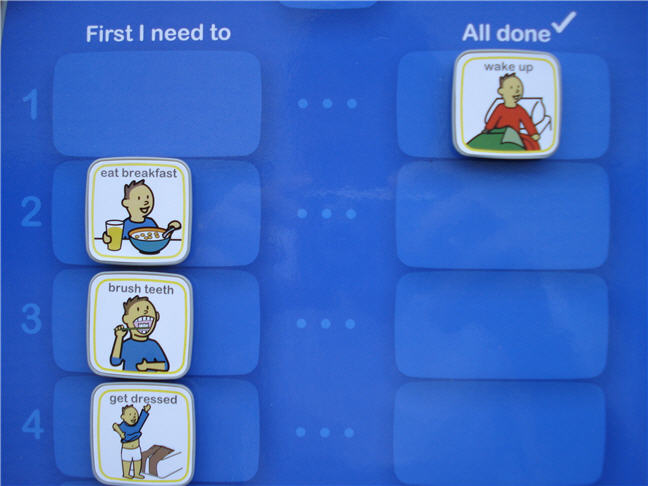Visual Schedules
What is a Visual Schedule?
A visual schedule is and easy and cost-effective way to provide students with structure and consistency throughout their day. It is a visual representation of the activities that will be occurring and in which order. Schedules can be designed in many different ways depending on the needs of the student. It is effective because when students can anticipate what is going to happen in their day anxiety and therefore problem behaviors will be reduced. Visual Schedules also provides motivation to students to work through more difficult activities if they can see an activity they prefer is scheduled afterwards. It will also help in creating a atmosphere of trust and security. Routine, structure and repetition have been found to be very effective ways of helping students with FASD deal with their memory deficits.
How to use a Visual Schedule
First a visual schedule must be created for the student. The schedule may consist of physical object, pictures, words or a combination depending on the students needs. It must also be noted that careful consideration must be put in to the choice of symbols being used to ensure that the symbols are age/student ability appropriate. For example, if a student has trouble reading, the use of pictures or physical objects would need to be used instead of words. The schedule should be organized in an top to bottom or right to left orientation. The student and teacher should go over the schedule at the beginning of the day and the student should be made aware of any changes that have been made to the schedule. The student should also be referred the schedule throughout the day while transitioning between activities. Once a student has completed an activity it should be marked off in someway or moved into a "completed" column or box.
Examples:
A visual schedule is and easy and cost-effective way to provide students with structure and consistency throughout their day. It is a visual representation of the activities that will be occurring and in which order. Schedules can be designed in many different ways depending on the needs of the student. It is effective because when students can anticipate what is going to happen in their day anxiety and therefore problem behaviors will be reduced. Visual Schedules also provides motivation to students to work through more difficult activities if they can see an activity they prefer is scheduled afterwards. It will also help in creating a atmosphere of trust and security. Routine, structure and repetition have been found to be very effective ways of helping students with FASD deal with their memory deficits.
How to use a Visual Schedule
First a visual schedule must be created for the student. The schedule may consist of physical object, pictures, words or a combination depending on the students needs. It must also be noted that careful consideration must be put in to the choice of symbols being used to ensure that the symbols are age/student ability appropriate. For example, if a student has trouble reading, the use of pictures or physical objects would need to be used instead of words. The schedule should be organized in an top to bottom or right to left orientation. The student and teacher should go over the schedule at the beginning of the day and the student should be made aware of any changes that have been made to the schedule. The student should also be referred the schedule throughout the day while transitioning between activities. Once a student has completed an activity it should be marked off in someway or moved into a "completed" column or box.
Examples:
Research supporting Visual Schedules:
Bryan, L. C., & Gast, D. L. (2000). Teaching On-Task and On-Schedule Behaviors to High-Functioning Children with Autism Via Picture Activity Schedules. Journal of Autism and Developmental Disorders, 30(6), 553-567.
Dettmer, S., Simpson, R. L., Myles, B. S., & Ganz, J. B. (2000). The Use of Visual Supports to Facilitate Transitions of Students with Autism. Focus on Autism and Other Developmental Disabilities, 15(3), 163-169.
Panerai, S., Ferrante, L., & Zingale, M. (2002). Benefits of the Treatment and Education of Autistic and Communication Handicapped Children (TEACCH) programme as compared with a non-specific approach. Journal of Intellectual Disability Research, 46(4), 318-327.



